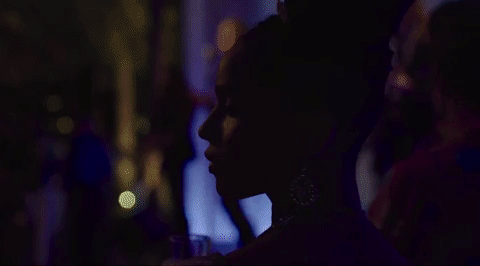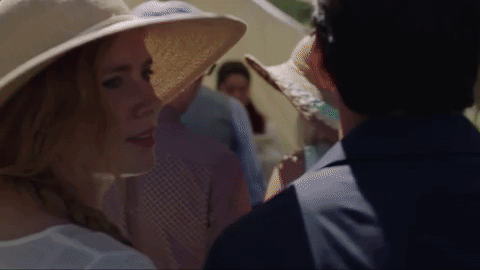Perhaps my favorite sequence in all of cinema is the opening to David Lynch’s Blue Velvet. The scene begins by panning down from a clear blue sky to a white picket fence fronted by red roses before fading away to show a fireman and his good boy Dalmatian driving through an idyllic suburb, and children walking through a crosswalk. We see an old man watering his lawn and an older woman watching TV, and then things take a turn toward the macabre. The man appears to suffer some kind of seizure; the woman’s TV screen shows a pistol. Lynch then takes us under the grass of the lawn, which is teeming with insects gnawing away at the soil below them.
What Lynch conveys—in a manner that, by his standards, is quite matter-of-fact—is the darkness that lurks in Small Town America; that under the veneer of an otherwise cheery community is something rotten at its core. This motif, which David Foster Wallace perfectly distilled as a nexus of the gruesome and the mundane, is the most familiar theme in the auteur’s work, which makes Lynch an essential chronicler of an inescapable, uniquely American atmosphere. Blue Velvet’s opening sequence resonates as much today as it did in 1986.
Interestingly, it is the Canadian director Jean-Marc Vallée—an auteur far removed from Lynch’s surrealist sensibilities—who best captured this mood and brought it into modern times. In the opening sequence to the then-series finale—though now we’re getting a second season—of HBO’s Big Little Lies, “You Get What You Need,” the twin sons of Nicole Kidman’s Celeste and Alexander Skarsgard’s Perry are playing video games in the living room, the rhythmic button-mashing providing foundational tempo for a filmmaker whose oeuvre is part Spotify playlist, part artistic ASMR. But as Vallée’s camera slowly zooms toward the living room’s air vent, we can hear the faint—though slowly progressing—sounds of Perry, a monstrous serial abuser, beating Celeste. The haunting shot draws a throughline between Perry’s treatment of Celeste and the twins—one of whom, we learn later in the episode, is responsible for hurting Amabella, the young daughter of Laura Dern’s Renata. The violence is spreading through the house—a chic property on the coast of Monterey, California—and unspooling across the community. The connective tissue of Big Little Lies is the prevailing trepidation that everyone is hiding something under their genial exteriors and exorbitant mansions—even if no one else is hiding something as fraught as Perry’s violence.
Big Little Lies juxtaposed its strains of suburbia with a murder mystery, spending seven episodes obscuring the victim and perpetrator of a killing referenced at the beginning of the season. Vallée’s Big Little Lies, working off David E. Kelley’s script and Liane Moriarty’s eponymous novel, builds this tension toward the town’s trivia-night fundraiser.
HBO’s newest miniseries directed by Vallée, Sharp Objects, also sets up a murder mystery and examines the hidden depths of depravity within a community. Once more, a big party is the device used to reveal the extent of the town’s rot. In both series, these parties are illuminating—the high point in shows full of high points. But how does Vallée make these moments so effective?
What both party scenes provide is an opportunity to throw all the characters into one place and see how they interact with and irritate one another. In both shows, Vallée provides myriad perspectives from these scenes by cutting between the eyelines of several characters, rather than homing in on a specific protagonist. In Big Little Lies, the camera takes turns following members of the quintet at its center—Kidman’s Celeste, Reese Witherspoon’s Madeline, Shailene Woodley’s Jane, Zoë Kravitz’s Bonnie, and Dern’s Renata—at different points in the evening, building up to their vicious showdown with Perry. In the fifth episode of Sharp Objects, “Closer,” we mostly follow Amy Adams’s Camille, Patricia Clarkson’s Adora, and Chris Messina’s Detective Willis as Adora hosts the town’s annual Calhoun Day: a celebration of Zeke Calhoun, whom Camille bluntly describes as the fictional Wind Gap, Missouri’s “founding pedophile.”
Vallée has a singular purpose in these scenes: guiding his characters toward an end without seeming predictable or overly predestined. This was especially tricky for Big Little Lies, which needed to throw all of its women together for a final confrontation with Perry just outside of the trivia-night festivities, setting up a character death that’s been gathering momentum since the first episode. The way Vallée achieves this is not unlike the experience in a narrative video game in the vein of Heavy Rain or Beyond: Two Souls— a playable character soaks up information by making their way around the room and chatting with non-playable characters as a means to an end. The on-screen NPCs, in the case of Big Little Lies’ trivia night, are the unsuspecting male partners of the core quintet, as well as the Greek chorus of townsfolk that has been (rather unevenly) relaying the events of that night in flash-forwards with authorities throughout the season.
It’s the townfolk’s obliviousness—of Monterey’s underlying problems, and of the tension between Perry and Celeste—that brings about the other characters’ clairvoyance. With Vallée’s camera, moments of clarity are depicted and made implicit by knowing glances across the room. Bonnie reads the body language between Perry and Celeste, and surmises the worst.

Granted, it does take the leading women of Monterey the better part of the season to unpack their respective secrets and insecurities—the series’ ultimate goal is to unite these women after the likes of Renata and Maddie spent so long trying to knock one another down a peg. These disparate threads come together in other ways across the party, Vallée working with his actresses’ expressions and glances more than he does with dialogue: Maddie, recalling her infidelity, runs away during her husband’s moving performance on stage; Jane trails behind hoping to console her; Renata then follows to apologize to Jane for blaming her son for hurting Amabella; Celeste runs away from Perry; Perry pursues; and, finally, Bonnie, putting it all together, pushes an attacking Perry down a jaggedy flight of stairs to his death.
From the outside, Perry and Celeste appeared to represent the idyllic American nucleus: a beautiful husband and wife raising two young children. That the family with the most enviable exterior contained the town’s biggest monster is the kind of contrast Vallée spent most of the season building toward. Perry’s death is the culmination of Big Little Lies’ first season, and the result of the unspoken agreements that resonate between the show’s central women. This is most pronounced in the way these women read the room at trivia night, and, in the end, craft a fake narrative to law enforcement after Bonnie saves the other women from Perry’s wrath. The setpiece’s crescendo might’ve been a violent end, but Vallée’s focus was less operatic: He let the characters do the talking, even if only through their wandering gazes.
On its surface, Sharp Objects portends to even more spectacular violence: In Wind Gap, two teenage girls have been murdered, and both had their teeth removed with pliers. “Closer” is almost entirely set within the confines of the annual Calhoun Day celebrations and is laced with dread: The town might be blowing off some much-needed steam, but so could the killer.
Again, Vallée gets to work with his full ensemble: The entirety of Wind Gap convenes, but much as Big Little Lies was as concerned with social standing as with the murder mystery at its center, the looming specter of the serial killer in Sharp Objects feels like a tangential danger, at best. The real threats in the town are knowledge and gossip when weaponized properly. (In this line of battle, nobody is better equipped than Adora.)
The festivities of Calhoun Day are a show within the show—the Crellin estate and its grounds serving as the framework for characters to unpack secrets and deliver understated humiliations. Vallée fixates on the nonverbal cues between Adora and Camille—a toxic mother-daughter dynamic that even a lifetime of therapy couldn’t fix. Adora disapproves of Camille’s flirtations with Detective Willis; Camille, upon seeing her mother’s displeasure, leans closer to him. Patricia Clarkson’s subdued anger is scarier than any pointed gun—and Vallée knows it.

Without dialogue, Vallée uncovers the town’s less-savory pieces through tracking their gazes across the sprawling space: No sooner does police chief Bill Vickery smile toward his wife than he is staring at Adora’s butt, studying it harder than he’s worked on the murder cases in months. (Vallée turns the camera back to Vickery’s wife, unamused and clearly used to his lecherous glares at the Crellin matriarch.) Adora waits for Camille to leave Detective Willis’s side, before giving him a guided tour of the house—emphasizing her daughter’s faults and insecurities. She shows him her bedroom floor, made by her ancestors entirely from ivory: A stunning encapsulation of a town’s stained and disturbed history.
The party crescendos with violence, but it comes with a catch. Amma Crellin—Camille’s half sister, played by Eliza Scanlen—performs a play that is a Calhoun Day tradition. In the play, she takes the role of Millie Calhoun, the child bride of Confederate soldier Zeke Calhoun. Millie is captured by Union soldiers, and refuses to give up her husband—the Union soldiers then take it upon themselves to rape and torture her as she’s bound to a tree, before setting the tree on fire. It’s not lost on the Sharp Objects brain trust that this is a … disconcerting tradition. The town celebrates its original sin—a cycle of women suffering in silence that is repeating itself with Wind Gap’s current, unsolved murders. However, in the context of the play, the violence that transpires is far less pronounced. But Vallée uses the Calhoun origins—through the blurred scope of Amma-as-Millie, who popped a hallucinogen just before performing—to juxtapose the performative violence of the play with the more disturbing violence that is teeming in Wind Gap proper. Before the play can conclude, Bob Nash—the father of the first victim, Ann—attacks John Keene, the brother of the second victim, who many in the town speculate is responsible for the killings.
The attack cracks the thin veneer of placidity surrounding Calhoun Day, and Vallée’s camera appropriately shifts into organized chaos. Bob is arrested and Amma runs away, straight into the woods; not since the Douglas firs of Lynch’s Twin Peaks has a forest exhibited such an overwhelming sense of ethereal evil. Vallée layers these scenes of chaos with the dread that comes with knowing that a killer is on the loose. As Adam Nayman wrote for The Ringer of Vallée’s direction, “the incessant glancing, often context-free inserts of props, objects, and locations vibrate with a Malickian sense of mystery.” It never feels more pronounced than when Calhoun Day goes to shit—and in a subversive twist, Camille finds her half sister in the woods scared but unharmed.
The Sharp Objects party scene is not the climactic setpiece of the series. The show has three more episodes to unpack the messy, complicated, and malicious dynamic between Camille and Adora, while presumably inching viewers closer toward the revelation of Wind Gap’s killer and how it relates to the Crellin family. We may not know how Sharp Objects ends—I’m not Googling!—but Vallée’s imprint on the story is unmissable, with Wind Gap seeming like an extension of the themes he conveyed with his camera in Big Little Lies by peering into the corrupted soul of über-rich Monterey. The answers will be there, even if they’re not put into words and instead communicated through a knowing glance that provides familiar satisfaction. Vallée will tell us all we need to know, one itinerant gaze at a time.
Disclosure: HBO is an initial investor in The Ringer.
